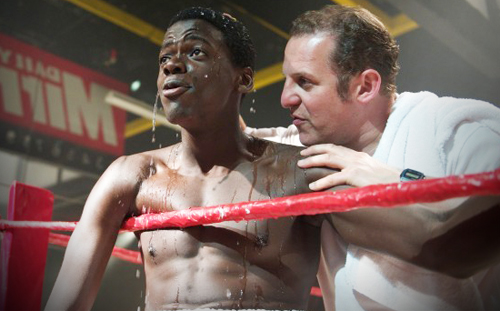
If, as Hegel argued, the only thing that can be deduced from historical study is that man never learns from history, The American Clock is a persuasive demonstration of that theory. The Finborough Theatre’s inclusion of Arthur Miller’s sweeping Great Depression drama in its Rediscoveries season has ‘timely revival’ written all over it – the resonance smacks you full in the face. Phil Wilmott’s production takes as its setting a modern day exhibition of depression-era photography, in a superb design by Philip Lindley, where Wall Street bankers look at the images but fail to truly see them. As one of the characters puts it, “people don’t know their own history”.
Miller’s play, not revived since its UK premiere at the National Theatre in 1986, takes a panoramic snapshot of the devastating Wall Street Crash and the years of economic depression that took hold in the aftermath. It is epic dramatic vaudeville squeezed onto the postage stamp-sized stage of the Finborough, but the compression has not sacrificed any of the quality. Miller works hard – occasionally too hard – to cover this crisis from every angle, presenting us with banker and farmer, businessman and prostitute, labourer and activist. The stage is consequently busy, but never feels over-crowded or chaotic thanks to Wilmott’s series of smoothly overlapping scene transitions.
Issy van Randwyck is the beating heart of the production as matriarch Rose
It can sometimes feel as though Miller is ticking off a checklist, and fans of his earlier plays might wish for more of a focus on the central Baum family, an affluent New York household forced to move to Brooklyn and reassess their lives. There is no doubt that Issy van Randwyck, who deserves particular mention in an excellent ensemble cast, is the beating heart of the production as matriarch Rose, while her son Lee’s struggle to go to college will be an all too familiar predicament for young people today. For such a far-reaching chapter of history, however, a wider lens seems appropriate, even necessary. By offering us passing portraits of other Americans from across the social spectrum, the struggles of the Baums are placed into essential context as one thread of a vast tapestry.
While we may not be very good at learning from past mistakes, what Miller recognised, and what this fine revival emphasises, is that only through the human stories of individuals are we likely to fully understand the story of a nation in crisis. Then, as now, it is the alternately heartbreaking and uplifting personal narratives that make the most powerful impression.
**** (4 stars)
Runs until 21st April
More info



Be the first to comment